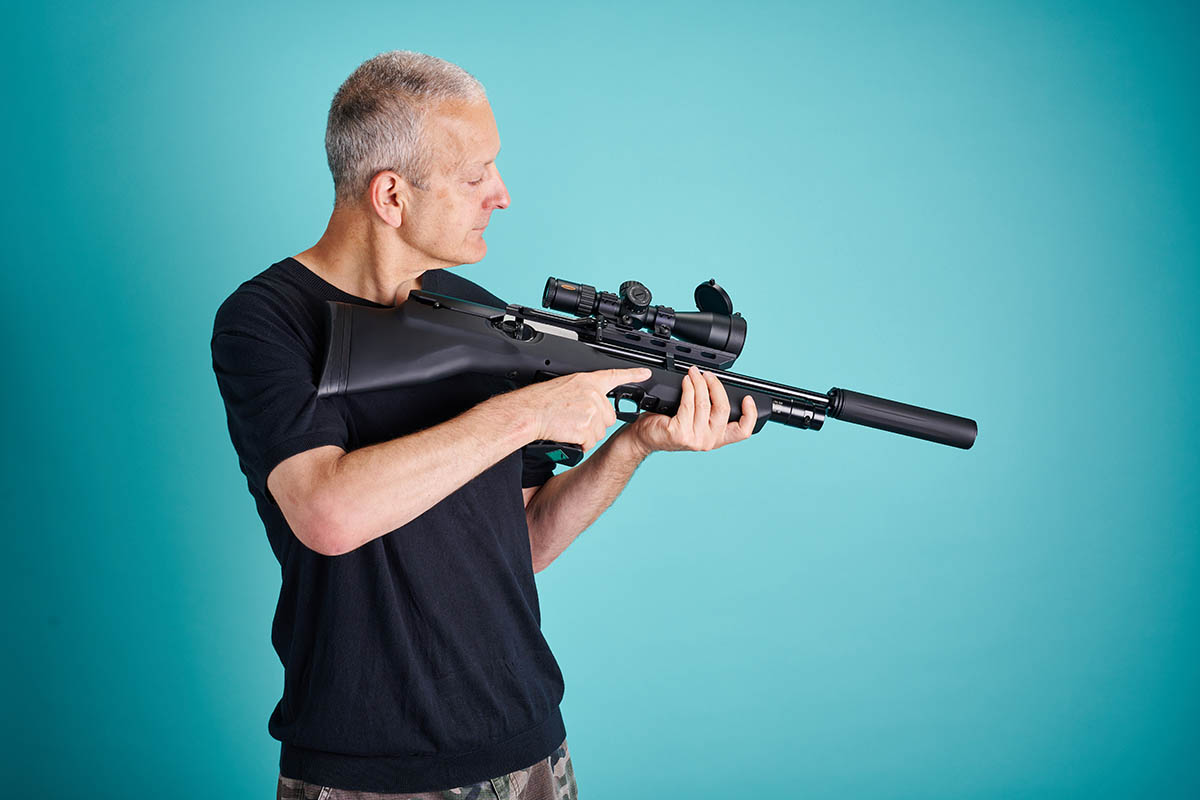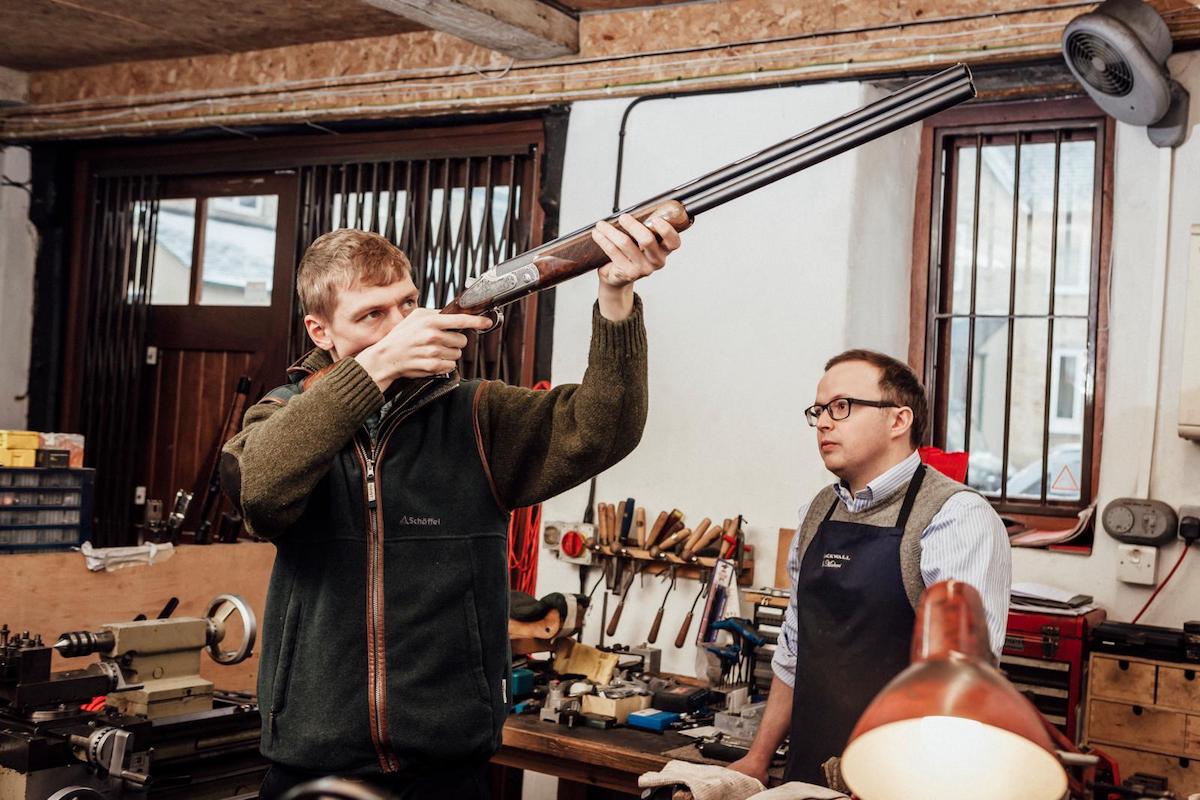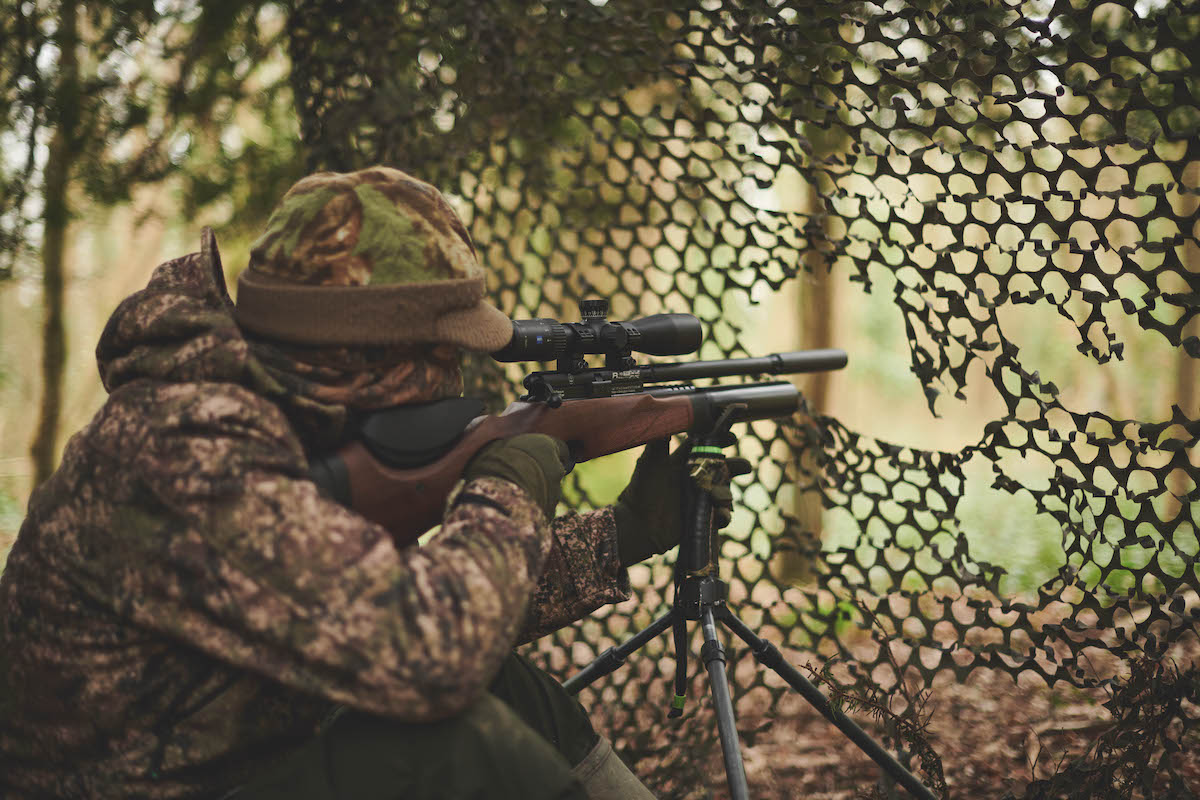How to get the most out of your air rifle – Mike Morton offers advice
Accuracy comes from both your airgun and the way you shoot it, Mike Morton offers a few suggestions to help you get the most out of your air rifle

We all aspire to be a marksman, which just means our ability to hit what we’re aiming at, and in order to achieve this we apply the four basic principles – getting stable, pointing the rifle correctly, understanding how to use the sights and knowing how to release the shot.
The little pellet that flies out of the barrel has a lot of work to do, and it really does need all the help it can get to make its point of impact coincide with the shooter’s point of aim. Here are a few tips and techniques that I’ve found useful. I hope they work for you too.
Use the correct scope mounts

The height of a set of mounts isn’t just linked to the size of a scope’s objective lens, but must be right for the shooter too, and these are too low
There’s no point going out and buying the scope of your dreams if you can’t look through it centrally, as you won’t shoot consistently well like this. One way to discover which scope choices will work for you and your rifle is to get hold of a variety of mounts of different heights. If you don’t have a selection in your stash already, you may have to borrow a set from a friend.
Install one set of mounts, close your eyes, shoulder the rifle, then open them. If your shooting eye is not perfectly central to the rear ring and you can’t adjust the height of the cheekpiece and/or the butt pad to make it so, you’ll have to try again using either lower or higher mounts. Once you’ve found the set that works for you, their height will determine the maximum size of objective lens you can fit.
Adjust height of comb

The cheekpiece, and therefore the height of the comb, is fixed on this stock, but is thankfully still high enough to suit most shooters
Good head and eye alignment is crucial to taking a successful shot when using a telescopic sight, but shooters will sometimes find themselves struggling with a scope that sits too high, and can’t use lower mounts. This could be due to the objective bell making contact with the scope rail or barrel, or the scope tube or saddle fouling the magazine.
In cases like these, you need to find a way to raise the cheekpiece, which is no problem if your stock incorporates this type of adjustment. If it doesn’t, the solution is to build up the height of the comb, one method being to make a riser block from a piece of wood and attach it to the cheekpiece using two dowels.
A far sketchier alternative technique is to cut a half-section of pipe lagging and tape it in place. It may look terrible, but it does work.
Fit a bipod

This stock isn’t ready to take a bipod out of the box, so an adapter would be needed in order to fit one via a sling swivel stud or Picatinny rail
Unless we’re in the field and the quarry presents itself a certain way, or we’re in a competition and the rules dictate otherwise, our goal should always be to take a shot from as stable a position as possible. And that usually means going prone.
The single most important piece of equipment for going prone is a bipod, assuming you’re shooting a PCP and have the means to attach it. A bipod will take much of the weight of the rifle, will make the gun more stable and will minimise muscle fatigue.
Bipods largely fall into two camps, those that attach to a sling swivel stud, and those that are fitted to a Picatinny rail, although there is some crossover, as adapters can be bought for both systems.
If your air rifle has no existing fitting underneath the forend, then one can usually be added by drilling locator holes for the relevant mounting system.
Adopt the right grip

Even though this pistol grip has been designed with a wraparound hold in mind, it’s still possible to shoot in the thumb-up position
The way we hold a rifle with our shooting hand can have a big impact on our level of comfort and control.
One method is the thumb-up grip. This is an ergonomic grip where the thumb points straight up instead of wrapped round the stock, whether it’s a standard sporter or has a pistol grip or thumbhole. Some shooters find this more comfortable as the thumb is lying naturally, with no strain on any muscles, rather than being forced to stretch around the grip.
Is it right for you? Try this test. Hold out your shooting hand, relax your fingers and see where your thumb is naturally lying. For many people, with their arm outstretched, their thumb will be pointing naturally forwards, in line with their arm, rather than sticking out to the side, meaning the thumb-up grip could be more comfortable for them and be a better option.
Magazine or single-shot loader?

Magazines and single-shot loaders both have pros and cons, and it’s up to the shooter to decide which one best suits their needs
Many multi-shot PCPs give the user the option of shooting it with a magazine or a single-shot loading device. Magazines work well, cycling the next pellet each time the action is cocked and presenting it in line with the bore.
Single-shot loaders, on the other hand, only have to channel the pellet into the bore, and may therefore offer a slight advantage over a magazine as the pellet will be lined up perfectly, with no chance of probing it into the chamber at an angle or, even worse, shaving some lead off while doing so.
But while single-shot loaders would seem to offer the most precision, they do suffer from one major disadvantage – the shooter must usually move their head and eye away from the aim while preparing the next pellet, which is not the case with a magazine. Which loading system is best therefore comes down to individual preference. Try both and decide.
Clean the barrel with a pull-through

BoreSnakes do a more thorough job than a regular pull-through, but can really only be used with break-barrels due to how they’re inserted
A dirty barrel will eventually affect accuracy. Having said that, accuracy can be affected if the barrel is too clean, and there’s an optimal level of leading. I clean a barrel after every tin of pellets, while some will clean the barrel of their airgun every time they shoot it, and others not at all.
Assuming you are keen to clean, ensure you get hold of the correct barrel-cleaning system for your rifle.
A pull-through, like the one from Napier, is ideal as this can be used with PCPs and underlevers, which don’t offer easy access to the bore, as well as break-barrels.
The BoreSnake, a thicker type of pull-through from US firm Hoppe’s, is excellent for break-barrels as it can easily be fed through a broken barrel from bore to muzzle, but is of no use in actions where access is restricted.
Adjust trigger-pull to taste

While a light trigger offers more precision and is generally desirable for range use, a heavier trigger-pull is a much safer option for the field
Trigger-pull is a measure of the amount of force that needs to be exerted on the trigger blade in order to get the sear to release, or the valve to open, depending on the type of rifle. Most air rifle triggers can be adjusted by the shooter, and the amount of trigger-pull you want to set will depend on the type of shooting you do, your own preference and any club or competition rules that may be in place.
Hunters may prefer a heavier trigger-pull of around 2lb to take account of cold, fatigue and the fact when wearing gloves, their trigger finger sensitivity is reduced. A pellet must be released at the moment a deliberate shot is taken, and a shooter should never be taken by surprise with the gun firing when they’re not expecting it.
Go steady with a laser

A dedicated laser bore-sighter or laser pointer can be used to project a dot onto a target to show how much the gun is wobbling
A laser is usually used to determine the distance of a target in relation to the scope’s set zero, or as a bore-sighting device. But there’s a third option – a training tool to see how stable you are in the aim.
A dedicated laser boresighter is great as it’s intended to be inserted down the bore, although some will only fit bore diameters of .22 and over. Not everyone has a .22 rifle or a laser boresighter, but many people do have access to a laser pointer, which is useful for giving presentations in an office environment.
If you have one of these, you can simply tape it to the barrel. It doesn’t need to be perfectly aligned as its sole purpose is to let you see how wobbly you are so you can either develop your technique and become more stable, or adopt a better shooting stance altogether.
Moderators aren’t inaccurate

This Weihrauch HW XL looks huge, but does a great job of sound suppression and is far lighter than it looks, so if you like it, fit it
In video games, screwing on a moderator to firearm is often accompanied by the double negative of the rounds becoming less powerful and range being reduced.
While that’s been done to balance the gameplay, it doesn’t work like this in real life. How about airguns? Has anyone ever told you your moderator will make your shots less accurate?
This myth has a grain of truth to it if the moderator is not concentric to the bore of your rifle and the pellet clips either the internal baffles or the edge of the exit hole, which will be revealed by inaccurate shots and a smear of lead around the hole at the end of the moderator.
A properly fitted moderator should have no negative effect on accuracy, and may enhance it as the pellet is leaving the muzzle of the rifle and flying into the still air encased within the device.
Practice makes perfect

Shooting off a bench is great for rifle and scope set-up, but if you intend to shoot in other stances, you need to practise them regularly
Like riding a bicycle, the shooting skills that we learn will stay with us for a lifetime. More or less. Because just like riding a bike, while we may still know how to shoot, unless we practise on a regular basis, those skills will become dull over time.
Exactly what we practise is also important. It’s hard to excel at all shooting disciplines and stances, but even if we swear we’ll never take a kneeling shot again, it’s still good to shoot this way from time to time to keep that particular skill ticking over and also offering us something different to the norm.
For most people, unsupported standing shots are the trickiest, but there’s no better way to appreciate the four principles of marksmanship than shooting this way, at least occasionally.
So there we have it: a few suggestions that will hopefully enhance our enjoyment of our sport. And I’d better practise what I preach. And that means getting out there and taking on some standers. Wish me luck!








